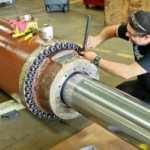Schematics: The Key To Troubleshooting
By: Ron Durante from Price On-Site

The use of schematics, such as this one, can save hours of time when troubleshooting a system.
Troubleshooting a complicated hydraulic system without a schematic is like trying to locate your destination without an address – you waste valuable time driving around. This is particularly true if there are manifolds within a given system.
A machine schematic is by far the best tool for troubleshooting complex equipment. In addition, a thorough description of the problem will assist in locating the source of the issue. With these 2 tools, you can effectively pick each problem off one-at-a-time.
If you use schematics for troubleshooting, make sure they are up to date. Organizing your schematics by asset name in electronic folders is a good way to keep files complete and accurate.
Taking photos of the equipment in question is also an essential (and often overlooked) step in troubleshooting. Not only do you document the problem, it will also help if you have to troubleshoot over the phone with a colleague, or customer, at a later date.
If you’re ever in a situation where the equipment is too old or no schematic is available, it’s best to simply sit down and sketch your own schematic. Although tedious, this extra step will save you a big headache later on.
Overall, the use of a schematic can quickly address possible causes of equipment failure and will undoubtedly save many hours of otherwise frustrating work.
Want to learn more about schematics and hydraulic system troubleshooting?
Sign up for Price On-Site’s Basic Hydraulics course!
More from my site
Leave a Reply
-
Archives
- August 2022
- April 2022
- August 2021
- December 2020
- August 2020
- January 2019
- September 2018
- March 2018
- February 2018
- December 2017
- November 2017
- October 2017
- September 2017
- May 2017
- April 2017
- March 2017
- February 2017
- October 2016
- September 2016
- August 2016
- July 2016
- June 2016
- March 2016
- September 2013
- July 2013
- March 2013
- January 2013
- December 2012
- November 2012
- October 2012
- September 2012
- August 2012
- July 2012
- June 2012
- May 2012
- April 2012
- March 2012
- February 2012
Signup Today
to get our monthly Enews delivered to your inbox.








